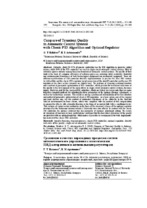| dc.contributor.author | Kulakov, G. T. | |
| dc.contributor.author | Artsiomenka, K. I. | |
| dc.coverage.spatial | Минск | ru |
| dc.date.accessioned | 2019-04-03T12:43:56Z | |
| dc.date.available | 2019-04-03T12:43:56Z | |
| dc.date.issued | 2019 | |
| dc.identifier.citation | Kulakov, G. T. Compare of Transient Quality in Automatic Control Systems with Classic PID Algorithm and Optimal Regulator = Сравнение качества переходных процессов систем автоматического управления с классическим ПИД-алгоритмом и оптимальным регулятором / G. T. Kulakov, K. I. Artsiomenka // Энергетика. Известия высших учебных заведений и энергетических объединений СНГ. – 2019. – № 2. – С. 192-200. | ru |
| dc.identifier.uri | https://rep.bntu.by/handle/data/51358 | |
| dc.description.abstract | Currently, about 90–95% of generic controllers use the PID algorithm to generate control actions, while 64% of the PID controllers are used in single-circuit automatic control systems. Most of industries (power industry among them) use hundreds of automatic control systems. The quality of their work is the basis of economic efficiency of technical processes, ensuring safety, reliability, durability and environmental friendliness of both technological equipment and automation equipment. There are different modifications of PID-controller structure implementation. In practice the ideal PID controller with a filter and the classic PID regulator (serial connection of the ideal PI controller and the real PD regulator as the direct action elements) are widely used. The problem of choosing a rational structure and a method of parametric optimization of PID controllers, which provide the best direct indicatives of the quality in the development of the main effects in single-circuit automatic control systems, becomes urgent. However, only for the classical PID controllers, which are widely used at present, there are more than three hundred methods for adjusting the three parameters of the optimal dynamic adjustment, as well as the ballast time constant. This results in arising a problem of substantiation of the best structure and method of parametric optimization of classical PID regulators. As a basic option, one of the simplest and most obvious one, viz. the method of automated adjustment of the controller in the Simulink MatLab environment had been chosen, which was compared with the method of full compensation in general for objects with a transfer function in the form of an inertial link with a conditional delay. Two variants of control action realization on the basis of the structural scheme of the optimal regulator developed by the Belarusian national technical University were also offered. In contrast with the classic PID controller, the optimal controller has one parameter of dynamic adjustment setting. The results of simulation of transients at basic perturbations confirmed that the best direct indicatives of the quality are provided with an optimal regulator, which makes it possible to recommend it for wide implementation instead of the classic PID controllers. | ru |
| dc.language.iso | en | ru |
| dc.publisher | БНТУ | ru |
| dc.title | Compare of Transient Quality in Automatic Control Systems with Classic PID Algorithm and Optimal Regulator | ru |
| dc.title.alternative | Сравнение качества переходных процессов систем автоматического управления с классическим ПИД-алгоритмом и оптимальным регулятором | ru |
| dc.type | Article | ru |
| dc.identifier.doi | 10.21122/1029-7448-2019-62-2-192-200 | |
| local.description.annotation | В настоящее время около 90–95 % типовых регуляторов используют ПИД-алгоритм формирования управляющих воздействий, при этом среди ПИД-регуляторов 64 % используется в одноконтурных системах. Большинство отраслей промышленности, в том числе энергетика, содержат сотни систем автоматического управления, качество работы которых является основой экономической эффективности технических процессов, обеспечивая безопасность, надежность, долговечность и экологичность работы как технологического оборудования, так и самих технических средств автоматизации. Существуют разные модификации реализации структуры ПИД-регуляторов. На практике чаще всего применяют идеальные ПИД-регуляторы с фильтром, а также классические ПИД-регуляторы как последовательное соединение идеального и реального ПД-регуляторов в виде звеньев быстрого реагирования. Актуальной становится задача выбора рациональной структуры и метода параметрической оптимизации ПИД-регуляторов, которые обеспечивают лучшие прямые показатели качества при отработке основных воздействий в одноконтурных системах автоматического управления. Вместе с тем только для классических ПИД-регуляторов, широко используемых в настоящее время, существует более трехсот методов настройки трех пара-метров оптимальной динамической настройки, а также балластной постоянной времени. Из-за этого возникает проблема обоснования лучшей структуры и метода параметрической оптимизации классических ПИД-регуляторов. В качестве базового варианта выбран один из самых простых и наглядных – метод автоматизированной настройки регулятора в среде Simulink MatLab, который сравнивался с методом полной компенсации в общем виде для объектов с передаточной функцией в виде инерционного звена с условным запаздыванием. Также предложены два варианта реализации управляющего воздействия на базе структурной схемы оптимального регулятора, разработанного Белорусским национальным техническим университетом. В отличие от классического ПИД-регулятора оптимальный регулятор имеет один параметр динамической настройки. Результаты моделирования переходных процессов при основных возмущениях подтверждают, что лучшие прямые показатели качества обеспечивает оптимальный регулятор. Это позволяет рекомендовать его для широкого внедрения вместо классических ПИД-регуляторов. | ru |

